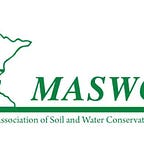Farmstead shelterbelt protects in windy NW corner of Minnesota
#MNLocallyLedConservation: Hemmes use Kittson SWCD, USDA-NRCS to establish rows of tree protection
Across the Red River Valley of northwest Minnesota, windspeeds commonly reach more than 40 miles an hour, leading to blowing snow that causes property damage and decreased visibility on roads.
Soil erosion also is a major concern with strong winds in an area where agriculture is a major part of the economy. Farmstead shelter belts historically have played an important role in preventing wind damage and soil erosion.
To protect against wind and snow, Dave and Tiffany Hemmes, of Humboldt, Minn., have worked extensively with the USDA-Natural Resources Conservation Service (NRCS) and Kittson Soil and Water Conservation District (SWCD) to establish and maintain an exceptional farmstead shelterbelt.
Farmstead shelterbelts also are eligible for enrollment in the federal Conservation Reserve Program (CRP) through NRCS.
In 2014, the Hemmes’ farmstead shelterbelt was planned with state cost-share funds. During the planning and design process, Dave and Tiffany worked with Kittson SWCD and the local NRCS. Jim Schwab, an NRCS soil conservationist, particularly was helpful with choosing trees and shrubs to plant on the Hemmes’ land.
As of 2020, the Hemmes have planted at least 2,000 trees.
This is one of the main reasons the Hemmes were chosen as Kittson SWCD’s 2020–2021 Outstanding Conservationist of the Year.
Conservation is a priority for the Hemmes because “it’s good for the land but it’s for the checkbook, too,” Dave said.
Surrounding their home on three sides and across the road are Flame Willows, Green Ash, Cottonwoods, Dogwoods, Lilacs, Apricots, Crabapples and Black Choke Cherries. They also have planted south of their home across the highway.
Since planting the trees, Dave has noticed they seem to make a big difference with snow removal. The Hemmes used to move snow constantly but now it is not much of an issue.
Additional shelterbelt benefits for the Hemmes are improved driving conditions in winter on nearby roads; reduced soil erosion; enhanced energy efficiency; and increased wildlife habitat.
After planting their shelterbelt, Dave and Tiffany have maintained and improved it. Some of the original trees didn’t survive from being damaged by wind and snow. Each year, the Hemmes replant trees where some died to prevent gaps in their tree rows.
They have applied fabric to protect against weeds between the tree rows but have found that it’s more effective to weed by hand around the trees and then spraying once the trees are old enough.
Tending to the trees is a family affair, and the children have been a big help, Dave said. Their kids help water, weed and seed the trees, he said, and they love it.
The Hemmes receive numerous compliments on their trees, especially the flame willows, which do all the work of cutting the snow and they are a fast-growing tree, Dave said.
Lilacs surrounding the house are attractive and make their yard fragrant in the spring.
Since planting the trees, the Hemmes have seen an increase in small, colorful birds and wildlife. A bear even visited their tree row this spring.
Anyone wanting to establish a farmstead shelterbelt, Dave said, should plan ahead and start early.
Since 1917, the Hemmes’ farm has operated for more than a century since Dave Hemmes’ great-grandpa established the homestead.
Today, the Hemmes farm wheat, soybeans and sugarbeets. Dave has farmed full-time for 14 year and says the best part of being a farmer is the freedom.
In addition to the family’s farmstead shelterbelt, Dave and his father are experimenting aerial seeding of barley in spring as a cover crop to protect their sugarbeet seedlings. They also implement best-management practices, such as soil testing, scouting and crop rotation.
The Hemmes find rotating crops as the most effective because it reduces pressure from weeds and insects while improving nutrient availability for crops. Rotating crops also has been shown to reduce erosion and protect the soil.
Together, the Hemmes’ conservation practices work to protect their land for future generations of farmers.
#MNLocallyLedConservation
